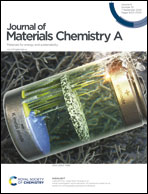Synergetic role of charge transfer and strain engineering in improving the catalysis of Pd single-atom-thick motifs stabilized on a defect-free MoS2/Ag(Au)(111) heterostructure†
Abstract
Developing highly efficient single-atom scale catalysts (SACs) stabilized on an appropriate substrate is of great practical importance due to the high catalytic efficiency and selectivity for many chemical reactions. Here, first-principles calculations are performed to report a synergetic role of charge transfer and strain engineering in significantly improving the stability and catalysis of single-atom-thick (SAT) two-dimensional (2D) Pd motifs on MoS2/Au(Ag)(111) heterostructures. When monolayer defect-free MoS2 is epitaxially covered on Au(Ag)(111), their lattice mismatch can induce tensile strain on MoS2 and their contrasting work functions result in charge transfer from the metal substrates to the MoS2 overlayer. Such a synergetic effect enlarges the binding energy and diffusion barrier of Pd on MoS2, which facilitates the atomic dispersion of the Pd adatoms on MoS2, forming SAT-PdN magic 2D nanomotifs with downward shifted d-orbital states, beneficial for the enhancement of O2 activation and reduction of CO poisoning. Consequently, the CO oxidation can proceed with low reaction barriers (0.4–0.6 eV) either on one or two atomically dispersed Pd reactive sites, facilitated by adjacent Pd atoms serving as electron donors. The present findings are expected to pave a new avenue toward design of a highly efficient new type of SAC on MoS2-based functional heterostructures.



 Please wait while we load your content...
Please wait while we load your content...